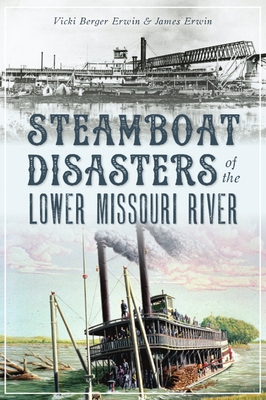Steamboat Disasters of the Lower Missouri River

Steamboat Disasters of the Lower Missouri River
During the nineteenth century, more than three hundred boats met their end in the steamboat graveyard that was the Lower Missouri River, from Omaha to its mouth. Although derided as little more than an "orderly pile of kindling," steamboats were, in fact, technological marvels superbly adapted to the river's conditions. Their light superstructure and long, wide, flat hulls powered by high-pressure engines drew so little water that they could cruise on "a heavy dew" even when fully loaded. But these same characteristics made them susceptible to fires, explosions and snags--tree trunks ripped from the banks, hiding under the water's surface. Authors Vicki and James Erwin detail the perils that steamboats, their passengers and crews faced on every voyage.
During the nineteenth century, more than three hundred boats met their end in the steamboat graveyard that was the Lower Missouri River, from Omaha to its mouth. Although derided as little more than an "orderly pile of kindling," steamboats were, in fact,
During the nineteenth century, more than three hundred boats met their end in the steamboat graveyard that was the Lower Missouri River, from Omaha to its mouth. Although derided as little more than an "orderly pile of kindling," steamboats were, in fact,
During the nineteenth century, more than three hundred boats met their end in the steamboat graveyard that was the Lower Missouri River, from Omaha to its mouth. Although derided as little more than an "orderly pile of kindling," steamboats were, in fact,
During the nineteenth century, more than three hundred boats met their end in the steamboat graveyard that was the Lower Missouri River, from Omaha to its mouth. Although derided as little more than an "orderly pile of kindling," steamboats were, in fact,
During the nineteenth century, more than three hundred boats met their end in the steamboat graveyard that was the Lower Missouri River, from Omaha to its mouth. Although derided as little more than an "orderly pile of kindling," steamboats were, in fact,
During the nineteenth century, more than three hundred boats met their end in the steamboat graveyard that was the Lower Missouri River, from Omaha to its mouth. Although derided as little more than an "orderly pile of kindling," steamboats were, in fact,
During the nineteenth century, more than three hundred boats met their end in the steamboat graveyard that was the Lower Missouri River, from Omaha to its mouth. Although derid
PRP: 148.74 Lei
Acesta este Prețul Recomandat de Producător. Prețul de vânzare al produsului este afișat mai jos.
118.99Lei
118.99Lei
148.74 LeiLivrare in 2-4 saptamani
Descrierea produsului
During the nineteenth century, more than three hundred boats met their end in the steamboat graveyard that was the Lower Missouri River, from Omaha to its mouth. Although derided as little more than an "orderly pile of kindling," steamboats were, in fact, technological marvels superbly adapted to the river's conditions. Their light superstructure and long, wide, flat hulls powered by high-pressure engines drew so little water that they could cruise on "a heavy dew" even when fully loaded. But these same characteristics made them susceptible to fires, explosions and snags--tree trunks ripped from the banks, hiding under the water's surface. Authors Vicki and James Erwin detail the perils that steamboats, their passengers and crews faced on every voyage.
During the nineteenth century, more than three hundred boats met their end in the steamboat graveyard that was the Lower Missouri River, from Omaha to its mouth. Although derided as little more than an "orderly pile of kindling," steamboats were, in fact,
During the nineteenth century, more than three hundred boats met their end in the steamboat graveyard that was the Lower Missouri River, from Omaha to its mouth. Although derided as little more than an "orderly pile of kindling," steamboats were, in fact,
During the nineteenth century, more than three hundred boats met their end in the steamboat graveyard that was the Lower Missouri River, from Omaha to its mouth. Although derided as little more than an "orderly pile of kindling," steamboats were, in fact,
During the nineteenth century, more than three hundred boats met their end in the steamboat graveyard that was the Lower Missouri River, from Omaha to its mouth. Although derided as little more than an "orderly pile of kindling," steamboats were, in fact,
During the nineteenth century, more than three hundred boats met their end in the steamboat graveyard that was the Lower Missouri River, from Omaha to its mouth. Although derided as little more than an "orderly pile of kindling," steamboats were, in fact,
During the nineteenth century, more than three hundred boats met their end in the steamboat graveyard that was the Lower Missouri River, from Omaha to its mouth. Although derided as little more than an "orderly pile of kindling," steamboats were, in fact,
During the nineteenth century, more than three hundred boats met their end in the steamboat graveyard that was the Lower Missouri River, from Omaha to its mouth. Although derid
Detaliile produsului










